FLYCRAFT BLOG

How the Flycraft Anchor System Works
Starting at the front, on the right hand side next to the rowers seat is the anchor cam. These are used to lock the anchor rope in place.

Get the lowdown on the new Stealth 2.0 Inflatable Drift Boat Lean Bar

How to load a Flycraft on a Subaru - a one or two person inflatable drift boat
We get a lot of questions about using the Flycraft Stealth 2.0 as a one person fishing craft.
It's is as much a one person inflatable fishing boat as a 2 person boat, but now when you’re fishing alone you’re in a boat that you can stand up and fish from, anchor, and transport easily.

VIDEO: Season Opener | Flycraft Presents: Lines & Logs | Early season fly fishing on new water
Sometimes we go out and we get a little lost somewhere in the western U.S. This is what happens when you're really excited to start fishing and it's still the early season, run off water.
On this trip we had Brandon, our sales manger and Clay, our shipping manager in the new Stealth 2.0.
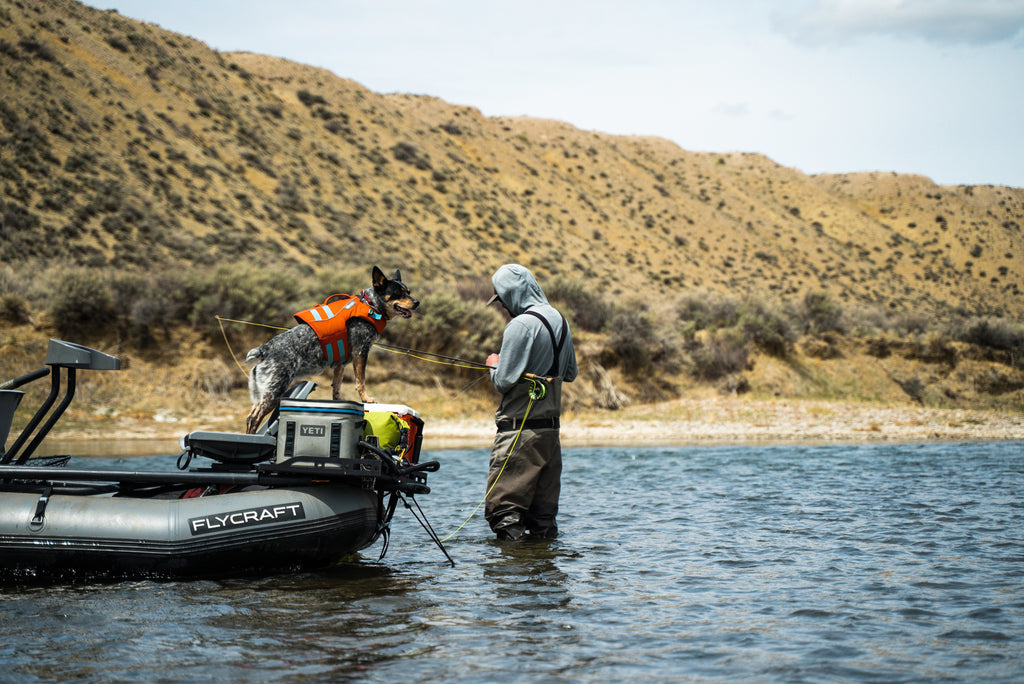
VIDEO: Wild Wyoming | Tales From The Craft EP - 03 | Flycraft fly fishing furlough for friends
In this episode of Tales From The Craft, we take a much more casual trip out to some very fishy waters. This is nothing but a bunch of friends wasting time out on the water instead of working.
Clay gets a little tipsy and Brandon gets a little mouthy. We find some real big birds and whole bunch of white fish.

Announcing the newest boat in Flycraft's line up: The Stealth 2.0
Hey, Brandon here with Flycraft and I'm excited to announce the newest boat in our line up, the Stealth 2.0.
At 11 1/2 feet long, this boat is very similar to our classic two man Stealth, but it's five inches wider, a total of 51 inches, which makes it more stable.

World Record Catfish Caught out of a Flycraft!
This past year Ben Christensen blew us away by catching a world record blue catfish out of his Flycraft in Texas, on a 4 weight fly rod no less!
Using an olive creek damsel fly tied to a size 10 Gamakatsu hook and 12-pound Rio Bass tippet, Ben secured an International Game Fish Association world-record.
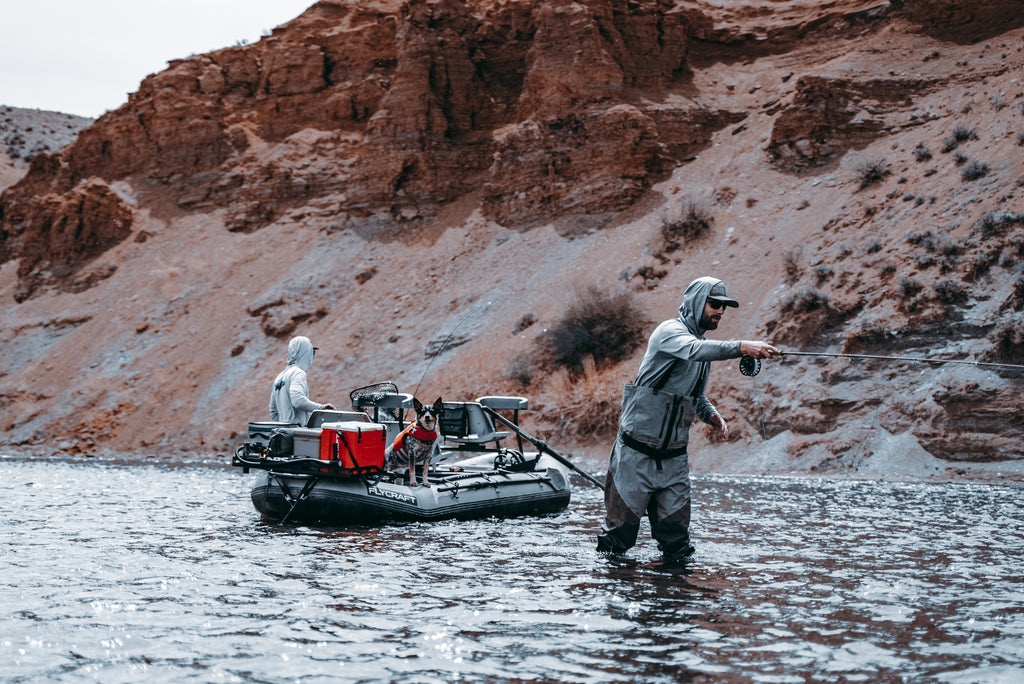
VIDEO: Fly fishing with dogs in a FLYCRAFT | Featuring the Princess of Flycraft, Pasta
We get a lot of questions about fishing with dogs out of a Flycraft. In this video we show you a few of our favorite spots for dogs to hang out in the boat so that you can fish, and they can join in on the fun.
Let us know if you have any other tips or trick for you and your dog.
As a quick warning, please never have your dog on a leash that is attached to the boat. In the unlikely event of flipping a boat the last thing you would ever want is to have you dog leashed to the craft.
LEARN MORE ABOUT FLYCRAFT INFLATABLE FISHING BOATS HERE >>
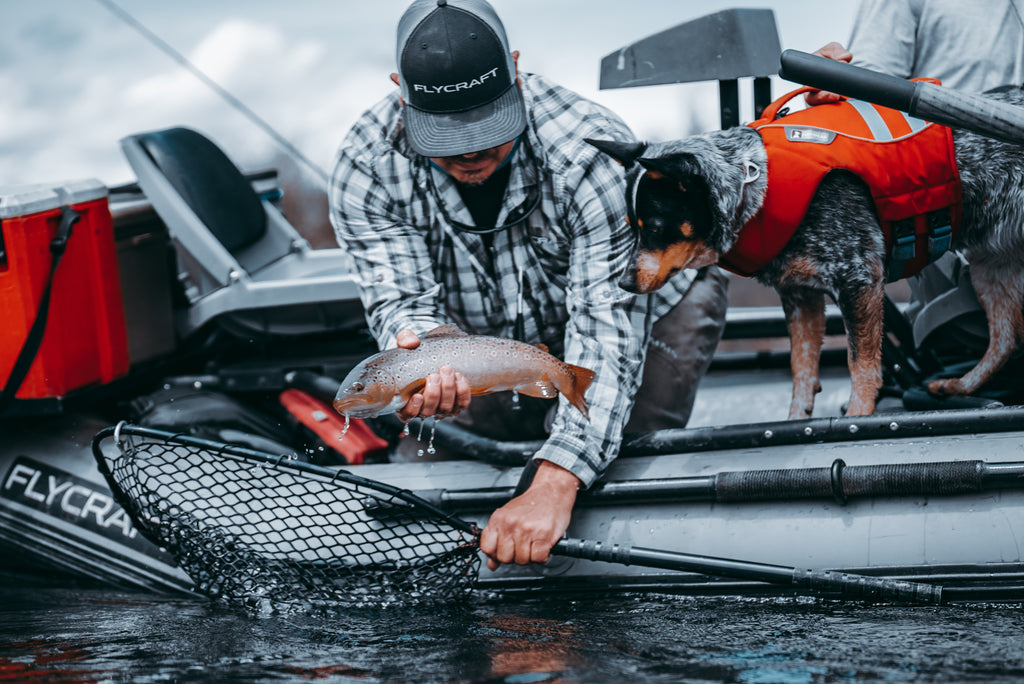
VIDEO: WY OH WY | a fly fishing short with the FLYCRAFT team
Some days you just can't be inside.
Some days the entire office can't be inside.
On those kind of days you hang the "closed" sign on the window and head north.
Getting off the asphalt and onto the long dirt roads that lead to solitude and a clear mind...
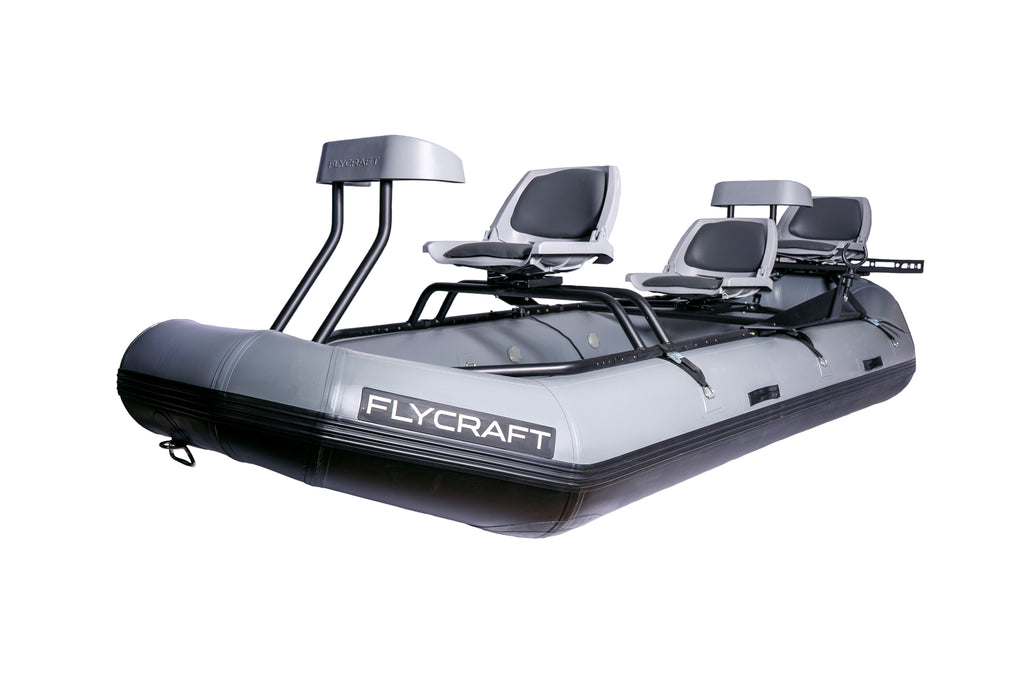
VIDEO: Everything You Need To Know About the Stealth X
We get a lot of questions about the Flycraft Stealth X and how it compares to our other Flycraft inflatable drift boat models.
In the video below, Brandon, Flycraft Expert, answers all the commonly asked questions about the X.
Check it out:
Time on the Video Questions Are Answered:
0:22 - How can you transport it?
0:46 - How many does it seat?
1:11 - What is the weight and dimensions of the X?
1:28 - Is it a self bailer?
2:14 - How does the lean bar work?
2:40 - How do you make the X into a three seater?
3:15 - How's the rod holder system on the X?
3:38 - What height person does the Stealth X accommodate?
3:57 - Is the Stealth X stable?
4:57 - How does the anchor system work?
6:22 - What kind of waters is the Stealth X good for?
6:54 - Is the Stealth X durable? Is it stable?
7:57 - How is the fishing line management in the X?
8:15 - What kind of storage options does the X have for gear?
9:33 - How rugged is the X?
11:04 - How does it hold up in salt water?
11:18 - What advantage does the X's boat rocker give me?
12:30 - Tell me more about transporting the X.
14:13 - What about adding a motor?
14:30 - Have more questions?
Video Transcript:
Hey, Brandon here with Flycraft, and I'm going to give you a quick little rundown on our Stealth X.
So the Stealth X, we launched a couple of years ago, and it really filled the gap between our classic two man Stealth, such as the Stealth Fisherman Package and then our 14 foot Guide boat.
How can you transport it?
Now, the Stealth X is 12 feet long, like the Stealth. So you don't need to transport it on a trailer. You can, but it rides on the roof of a car, like a Subaru SUV, bed of a truck, no problem.
Although it's 12 feet long, it's probably a little bit more similar to our Guide inflatable fishing boat. It really has pretty much the exact same frame as our Guide boat. Really, the biggest difference is the back of the boat is a little bit shorter.
How many does it seat?
This boat comes standard as a two seater. To make it a three seater, what you'll do is add the gear rack and the third key component with the optional rear bar.
Now, that third seat on this boat actually mounts to the gear rack. It's on a quick release, so if you don't have three people with you that day, you just press a lever, the third seat comes off. Kind of a perfect hybrid because people always want to fit three people in one of our boats. But 14 footers won't work for everyone.
What is the weight and dimensions of the X?
The boat is one hundred and thirty two pounds, 12 feet long. Fifty six inches wide. So it is ten inches wider than your classic two man Stealth. It also has slightly bigger tubes, so it has 16 inch tubes versus 14.
Is it a self bailer?
One nice feature about this boat as well is it's also a self bailer. If you're not familiar with self bailing, basically water comes in the boat, whether it's rain rapids, wearing boots, wet dog, whatever, it's going to drain out on its own.
Now, we put a lot of time into designing the self bailing system. I know there's videos from years ago where I don't have the best opinion of self bailing boats, and I was very vocal about that, which is why we didn't adopt any existing self bailing technology and we designed our own.
I'm happy to say with this system, you have the benefits of self bailing without the disadvantages that sometimes come with self bailing boats. They historically can be more sluggish. They don't track as well. And we've kind of eliminated those problems.
How does the lean bar work?
So if you get this boat set up as a two seater, it does come standard with that front leg lock. What I like about our lean bar system in the front is unlike a lot of rafts where it's simply just a bar, ours is modeled after drift boats.
So you have this molded leg locks, which is really helpful for when you're standing and leaning forward. But we find we're often standing sideways. You can just lock one leg in, which is really nice. So it's just it's a lot more secure. It is removable. So if you ever want to take it off, you can.
How do you make the X into a three seater?
Like I mentioned before, if you want to make it a three seater, you just add the gear rack in the third seat. And if you had the rear lean bar, it just simply bolts on. It's also easy to remove.
A lot of people have some confusion on spacing in this boat. They think that if they get the Guide model, then they're going to have more room for the anglers. And that's actually not really true.
The third seat in this boat really has just about as much room for a third angler as there is in the Guide model. So although it's two feet shorter, really, the difference is the third seat mounting to the gear rack versus the Guide model where the gear rack sits behind it.
How's the rod holder system on the X?
Now, we also have a really nice Rod Holder System for this boat. It holds three fly rods. It also holds conventional spin style rods as well. You can get it without the gear rack, but it definitely pairs better with the gear rack because we have a bracket on the underside of the gear rack that holds the tubes.
We designed our rod holder so that you can easily access the rods, whether you're sitting in the rower's seat or the front seat of the boat.
What height person does the Stealth X accommodate?
We designed our boat to accommodate people of all height. Since the oarlock arms are adjustable, you can mount them in various different positions with the whole pattern on the frame, as well as slide the seat forward or back. It doesn't matter if you're five foot two or six foot eight, you're going to be able to adjust this in a comfortable place for rowing.
Is the Stealth X stable?
As I was mentioning, this boat is 10 inches wider than a regular Stealth. And a lot of people look at our boats and say these are narrow. Is it a stable boat? And I think all of our boat models are very, very stable.
If you've ever fished in our skinny or two man boat, I think you'd be surprised how stable it really is. I think for lack of a better term, the Stealth X, as well as the Guide, have more of a foolproof stability.
Being 10 inches wider with slightly bigger tubes does mean that when you're in pushy'er currents, you can get away with more. I don't have people calling me, telling me they're flipping their boat over. When they do, it's normally an embarrassing story. You know, things happen. But this is a very surprisingly stable boat, although it looks narrow, it's very stable. And part of that is since we do have smaller tubes compared to a lot of whitewater rafts, that might be 20-22 tubes, we actually have a similar flat bottom width than a lot of those boats with bigger tubes. Even though it's a narrower boat, the smaller tubes allow you to have more flat bottom.
How does the anchor system work?
So like all of our boat models, the Stealth X comes with our internally run anchor system, it come standard with the two to one mechanical advantage.
Few things I like about this is:
1) Two to one mechanical advantage means when you're lifting a twenty five pound anchor, it feels like half the weight. When you're out floating all day, lifting that anchor can get tiring. That helps you out a lot.
2) Another thing is it gives you a completely centered anchor point. Now, you can do this two to one system if you want. I don't recommend that for river use, because then you're not going to have a centered anchor point.
3) If you're out on a lake and you want twice the depth because, you have about 20 feet of anchor line with the two to one. So you'll have roughly about 40 if you can do that. So if you're fishing still water, you can certainly undo that system and have more anchor ability.
4) As I mentioned, it is an internally run system. So one thing that's critical in a small boat is keeping it really clean. Line management. We don't want any more excuses than we already have for missing a fish. So tangling your fly line on external pulley is running through the frame can be really annoying.
We've eliminated that by running the anchor system through the frame. I also heard a story recently where someone's dog's tail got stuck in someone's anchor system because it was externally run. So we've eliminated that. It makes it safer for you, your dogs, and ultimately one less excuse for losing a fish.
What kind of waters is the Stealth X good for?
Now, although you probably see, we probably spend most of our time fising rivers, we do fish lakes a lot and a lot of our customers do as well. This boat is really great for small streams, big rivers, lakes, oceans, ponds and everything in between.
I sell a lot of these boats to people on the Texas coast chasing redfish. Even Florida. So whether you're rowing or motoring, it's going to perform much better than pretty much any other inflatable. Once again, because it is narrower. It's streamlined. It tracks really well.
Is the Stealth X durable? Is it stable?
Another unique thing about the Stealth X and really all of our boat models, as you may know, we have what's called a drop stitched floor. We love the advantage of the inflatable.
We can drag it down the bank, bounce it off rocks, access rivers and remote stillwaters that we couldn't with a hard boat. A lot of rafts have a squishy floor, which can be fatiguing. It also makes it not row as well.
If you've ever seen those inflatable stand up paddleboards, we have modeled our floor off of that. So the drop stitching basically are thousands of stitching fibers. They really look like floss that attaches the top and bottom of the floor together.
What that allows us to do is add a lot more air pressure to the floor than we can in the tubes. Now, the tubes are going to feel firm to your touch, but if you're standing on them, they're going to have more give when you put the appropriate amount of air pressure in this floor.
It literally feels like you're standing on a board. But in this boat, you have six inches more of buoyancy. So we're going to ride higher than a drift boat. It tends to be about a three to four inch draft. And you don't need to worry about building out a floor platform because the floor is already rigid.
How is the fishing line management in the X?
Since we cater these boats in the frame builds specifically for fishing, whether you're fly fishing or conventional fishing, a clean design for line management is really important. We put a lot of thought into that. So there's really nothing in this boat that's easy to snag your line on.
What kind of storage options does the X have for gear?
Another thing about it is, since it is a small boat, storage is really essential. So that's why we have a gear rack.
Now, if you only have two people on the boat, that gear rack is free for whatever you want to put. You know, I probably have some more essential items, maybe a cooler with some beverages. My fishing bag, that type of thing is stored underneath the seat or the seats, I should say.
And that front seat is elevated so that you can fit most coolers and boat bags or boxes underneath there. But the gear, it's a great place for some of those nonessentials. You might bring a grill. You're certainly going to have a dry bag with a first aid kit. Rain gear, cold weather gear, that type of stuff. So for the items that I'm accessing, you know, maybe only once throughout the day or I bring along hoping not to use, like a rain jacket, the gear is really great for that.
But you do, like I said, have storage space under both seats as well, and even under the third seat, if you put it on the gear rack.
Now, a lot of people wonder if they are mounting the third seat, do they lose all their gear rack storage? You certainly lose some. You're not going to have that bigger, cooler back there. But as you can see here, even with the third seat on it, there's plenty of room for some dry bags, a soft cooler, that type of thing.
How rugged is the X?
Now, oftentimes when we're fishing, we find ourselves in some pretty rough spots, we're dragging the boat down the banks, bumping into logs, rocks, that type of thing. And some people have concerns with inflatables for that. Inflatables have been around for a really long time for really rugged to use like that.
And that's certainly what we built this boat to do. And we reinforce the bottom of the boat. The entire bottom is two layers of 1100 tinnier PVC. But we really find most of the brunt of the abuse happens on the corners, on the bottom of the boat.
So on all four corners, we actually have it reinforced with two more layers. So each corner is four layers thick. And those patches are certainly meant to get wear. But like I said, the whole bottom of the boats, two layers.
And you also have five separate air chambers. It's probably not going to be a rock or a stick that causes you to spring a leak. It pretty much never is. But I've been guilty of putting the knife through the boat before. It's embarrassing, but things happen. And if you do ever puncture the boat, the boat's not sinking on you because you have five separate air chambers.
Just like the boat itself is very durable, the frame is as well. And we actually hand-build these frames, along with pretty much all the accessories.
So we put a lot of time on quality control and just overall fishability and durability of the frame. We build our frames out of aluminum. They're all welded here in Salt Lake City. Then we actually powder coat them as well. Since it's powder coated and we use all stainless steel hardware.
How does it hold up in salt water?
This boat's fine for saltwater use. It holds up really well, just like anything else in the sea, you want to hose it down after use. But the PVC raft in the frame itself are good to go.
What advantage does the X's boat rocker give me?
As you can see here, we build all of our boat models with a lot of rocker, more so than most rafts on the market. Now, rocker is the lift that's in the bow and stern of the boat. This is a huge advantage when you're running rivers' with swift currents. If you're navigating boulder gardens, trying to ferry across a river, this rocker allows the water to rush under the boat a lot easier.
It also means that although it's a 12 foot boat, it handles like a shorter boat because we have less boat in the water. You still have the usable space inside the boat for storage and standing and fishing. But you ultimately have less boat in the water, something that people often don't think about with the rocker as well as it helps a ton with anchor-ability.
A lot of rafts don't have as much of the rockers. So when you're trying to drop anchor, the current is pushing against the back of the boat, which means you might not hold anchor where you wanted to and you might need a much heavier anchor to do this.
So when you drop anchor with our two to one system, the water's just going to rush under the boat and it's going to hold a lot better than most, which is why a lot of people are surprised. We only use a twenty five pound pyramid anchor, whether I'm on a fast river like the Madison or a snake or, you know, some slow river like the Henry's Fork.
Tell me more about transporting the X.
So one thing we've always aim to do since the get go, when we launched our very first Stealth boat about 10 years ago or so, is solve transportation issues for people.
Getting a boat can be overwhelming. For some people, storage space, how they're going to transport it, they might need to buy a truck and trailer to move it. So you can put it on a trailer. And I do that sometimes.
But it will also just fit in the back of the truck. Even if you have a short bed truck with the tailgate down, you'll be supporting more than half the length of the boat. So you can get one of those tailgate hitch extenders, but you really don't even need to.
Another thing is it'll go on the roof of the Subaru, fully inflated, assembled. A lot of people wonder, they're like, well, can I drive on the highway with it? Absolutely. I mean, I'll drive from Salt Lake City to Bozeman, 80 plus miles an hour the whole way for six hours.
And it transports fine up there so you can get it on the roof of a Subaru SUV or back of a truck, but you can also even break it down if you want. You certainly can break the frame down completely, which is very popular for people with smaller cars or especially RV's campers, that type of thing.
You also can choose to just split the frame maybe in half or in thirds. Another thing that I like to do a lot is if I don't feel like breaking the frame down, I'll just take a few seconds to unstrapped the frame from the raft itself.
I'll put the frame up on the roof of the vehicle. I mean, you can get it up there. The frame itself alone, even on like a tall SUV, like a forerunner or something. Get it up there. Strap it down and roll the boat and put it in the trunk. Now, you're not really affecting your gas mileage much and you don't need to spend much time with the strapping. Not that it's really that hard to strap anyways.
What about adding a motor?
The Stealth X, along with all of our boat models, can be paired with a motor if you want. My favorite and the one that we offer is a hundred two point three horsepower. This boat is rated up to as high as a three point five horse if you want. Electric motors are also a very popular option.
Have more questions?
So thank you for taking the time to learn more about the Stealth X.
We also have a lot more resources on our website. Social media is a great place to look as well. But as always, you can always reach out to me via email or phone.
LEARN MORE ABOUT THE STEALTH X INFLATABLE FISHING BOAT HERE >>
![[VIDEO] Fly Fishing South Fork of the Snake River | FLYCRAFT FLOATS THE SNAKE](http://www.flycraftusa.com/cdn/shop/articles/Bridge_to_Takeout-10_1024x684.jpg?v=1633724856)
[VIDEO] Fly Fishing South Fork of the Snake River | FLYCRAFT FLOATS THE SNAKE
The state of Idaho has endless opportunities for floating and fly fishing but hands down one of our favorites is the South Fork of the Snake River in Swan Valley, Idaho.
This beautiful river starts up in Yellowstone National Park, flows through Jackson Hole, Wyoming before it crosses into Idaho and eventually joining the Columbia River on its way to the Pacific Ocean. Although pretty much every section of it fishes, our favorite through and below Swan Valley, Idaho.
Check it out:
This past August, Flycraft Videographer Kevin Landgren, Sales Manager Brandon Collett, and long time friend and fishing buddy, Chris Jenney, made the 4 hours drive from Salt Lake City, Utah to Idaho for a few days of fishing, floating and most of all having a good time.
Chris actually was one of our first co workers at Flycraft when we first started, but many years later and PhDs for Chris, he's now a fisheries biologist in Arizona. It was good to get the crew back together as you'll see from the river banter in the video.
Day 1: We got up there mid afternoon and launched the Flycraft Guide 3-Person Inflatable Fishing Boat for a short float before dark. Dry flies were the answer that evening, which for us is as good as it gets. Despite all the mayflies and caddis on the water, the fish liked our larger floam attractor patterns the best, which was perfectly ok with us. Many fish were caught, even more were missed, and it couldn't have been more fun.

Day 2: We launched in the morning for a 14 mile float, expecting to see trout eating our dry fly like the day before. As we often find while fishing, for whatever reason the fish had other ideas that day.

In addition to great fishing and lots of laughs, per usual, the Snake River did not disappoint on scenery. Moose, deer, otters and large birds of prey are a regular occurrence in Swan Valley. It's pretty incredible fishing a run from the boat with a giant golden eagle sitting on a limb above you watching.
![[VIDEO] How To Euro Nymph With George Daniel](http://www.flycraftusa.com/cdn/shop/articles/George_D-21_1024x684.jpg?v=1631118381)
[VIDEO] How To Euro Nymph With George Daniel
This July we were lucky enough to have one of our favorite anglers in town, George Daniel. Unprecedented low waters in the west made our choice of where to fish an easy decision, Utah's Green River.
Although running at half the flow we normally see it that time of year, the water was cold and easily navigable in the Flycraft Stealth X.
Check it out:
To be honest, we were expecting great dry fly fishing. We had heard that the hatches were in full force and the terrestrial bite was on.
As we all know, these conditions can change in a hurry and meeting George at our campsite in a full force rain storm made us wonder what was in store for the next day.
The following morning George, our Sales Manager, Brandon Collett, and Pasta the Fisher Dog, put in below the Flaming Gorge Dam on the Green River with optimism.

Ominous strong winds and overcast skies made us doubt the dry fly game but we still tried it for hours. The fact of the matter is, we were there to catch fish and a change of pressure/weather or technique wasn't going to keep us from it.
Fortunately, George may be the best nympher out there (or at least one of the best we've seen). After trying some more traditional methods we were happy to see George switch tactics and do what he is known for: Euro Nymphing.

It was our first time seeing this technique out of the boat and we were blown away. After a tough first few hours, it was like a light switch was flipped, in no time George was bringing in trout after trout.

We definitely learned a lot from watching and hope you will too.
If you would like to learn more about this technique or George Daniel, check out his website or his books below.
For those who may not know who George, he has rightfully made a name for himself more than probably anyone else in the fly fishing industry. With his roots in guiding in Western Pennsylvania, George has gone on to write two of the best selling books in fly fishing: Dynamic Nymphing and Strip Set.
In addition to his guiding and writing, George travels the country giving lectures and clinics on his passion. A couple years ago, he also joined on with Penn State University as the Professor of Fly Fishing.
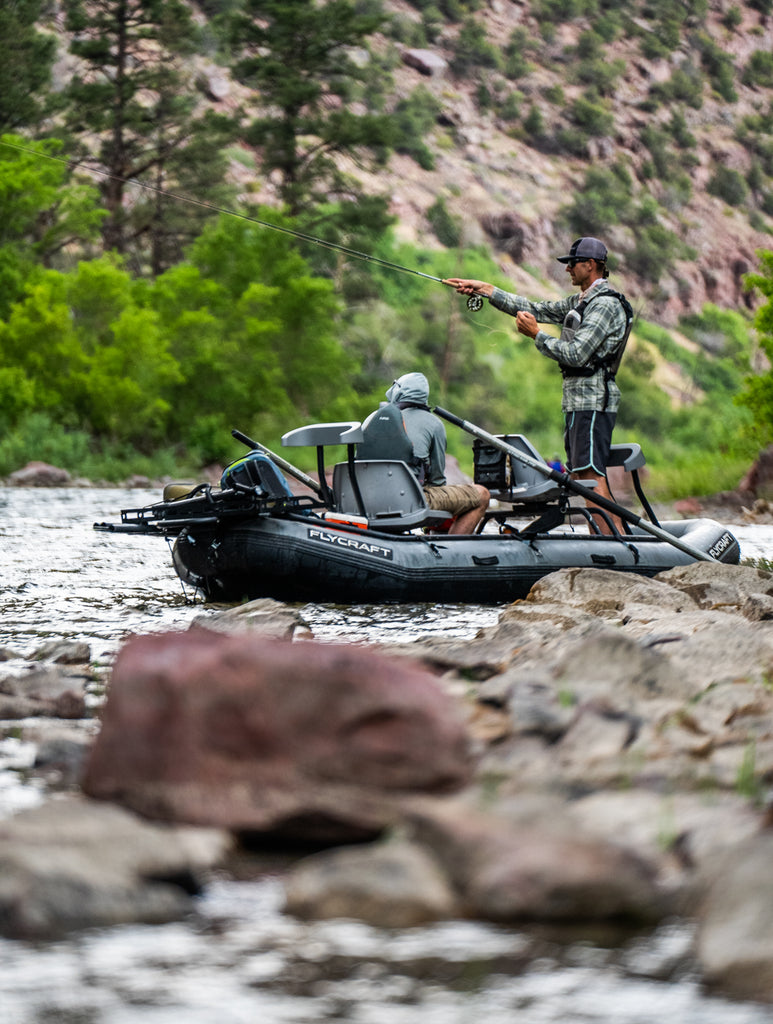
Years ago, George joined on with us as one of our Flycraft Pro Anglers. For the smaller streams and some larger rivers in PA, our boats, including his new favorite, the Stealth X, seem to be the ticket.
George's annual summer trip to the West is one of our favorite times of the year when we get to row him down the river, watch him fish and spend time with someone who has become a good friend and addition to the Flycraft family.
George Daniel | www.livinonthefly.com


